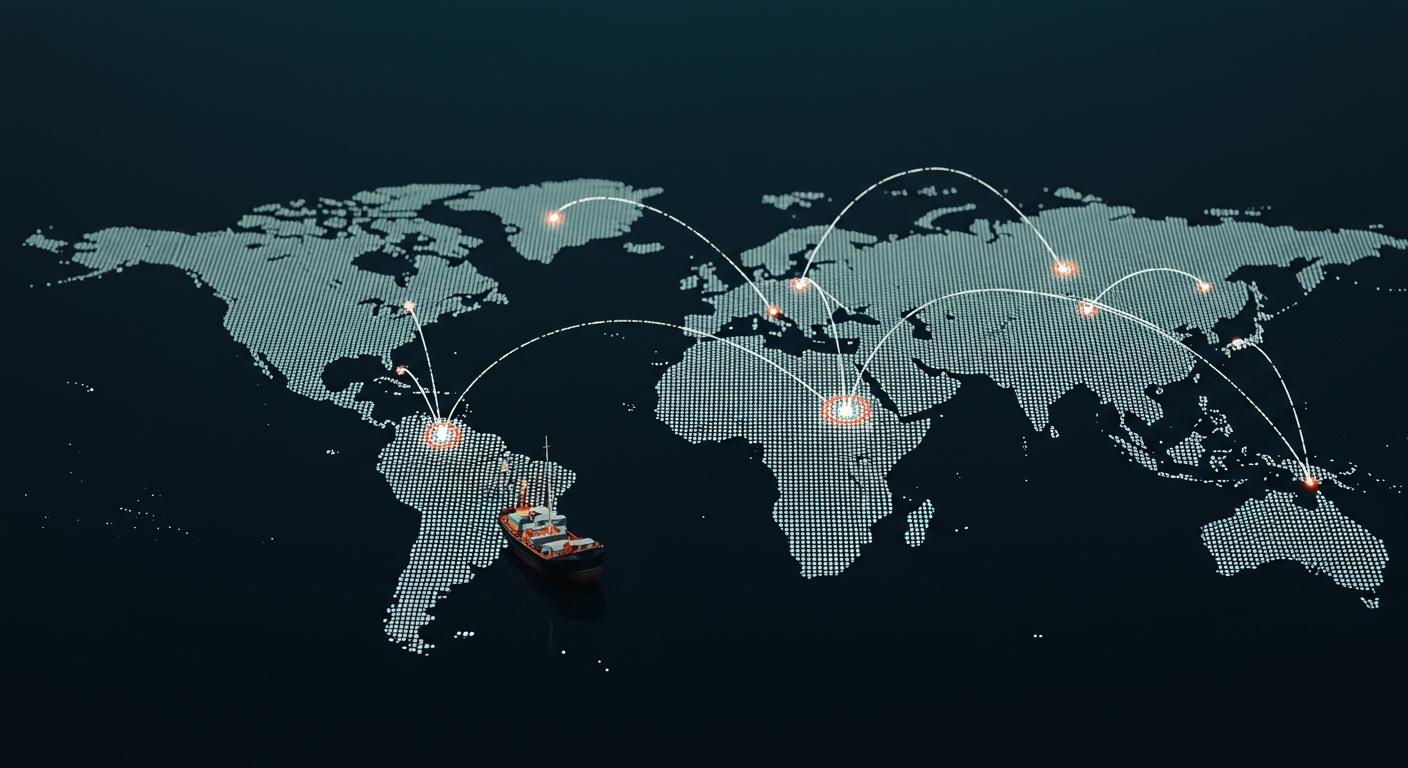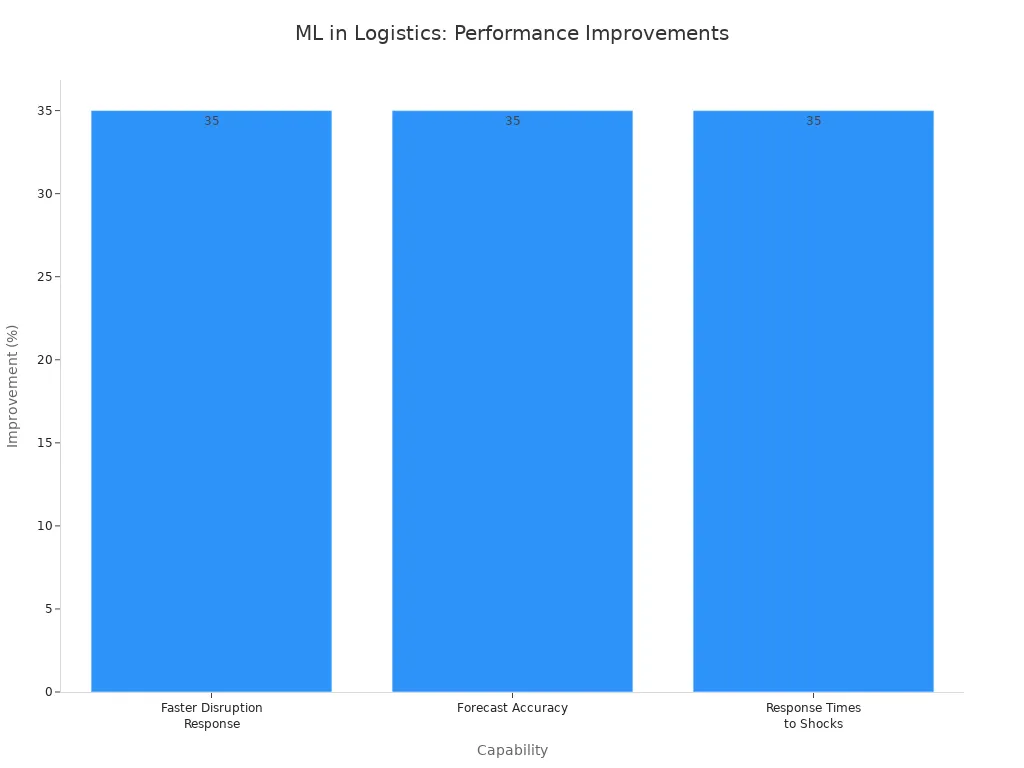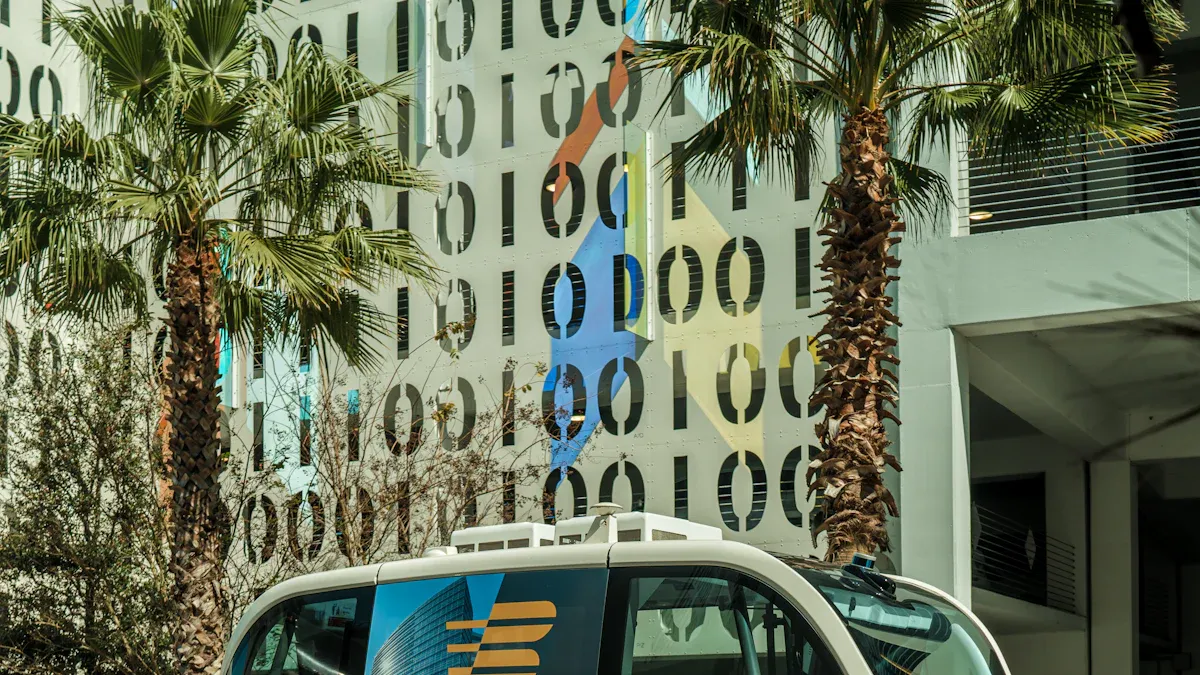
A logistics manager often faces a familiar problem: an unexpected port closure derails a critical shipment. This scenario creates costly delays and frustrates customers.
Machine learning offers a proactive, not reactive, solution to these disruptions.
This technology analyzes vast real-time data to predict delays before they occur. With 50% of the industry already using machine learning in logistics for dynamic route planning, systems can automatically adjust shipping routes. This ensures cargo avoids bottlenecks and stays on schedule.
How Machine Learning Helps Optimize Routing

Machine learning transforms route planning from a static task into a dynamic, intelligent process. It uses data to make smart decisions in real time. This system helps companies optimize routing and improve shipping time predictions. The core of machine learning in route optimization lies in its ability to process vast information, predict future events, and suggest the best course of action.
Data Collection for ML Models
Effective machine learning models need high-quality data. The system gathers information from many sources to build a complete picture of the logistics network. This data-driven modeling is the foundation for accurate predictive analytics.
Key data types include:
- Real-Time GPS: Provides the current location of every vehicle. Real-time tracking is essential for monitoring progress.
- Weather Forecasts: Predicts conditions like storms or high winds that can slow down shipments.
- Traffic Patterns: Offers live updates on congestion, accidents, and road closures.
- Historical Transportation Data: Includes past trip details, delivery times, and delays.
- Vehicle Telematics: Sensors and in-vehicle cameras collect data on driving behavior, engine health, and fuel levels. AI algorithms analyze this data to find routing inefficiencies and predict maintenance needs.
This comprehensive data collection allows the system to move beyond simple A-to-B routing. It enables a holistic approach to route optimization.
How to Predict Shipping Delays
Once the data is collected, machine learning algorithms get to work. These algorithms use predictive analytics to forecast potential problems. The goal is to predict shipping delays before they happen. This process improves the accuracy of shipping time predictions.
Algorithms analyze historical data to find patterns. For example, an algorithm might learn that a certain highway gets congested every Friday afternoon. This allows the system to predict shipping delays for future trips. Techniques like random forest and gradient boosting are highly effective. Studies show these models achieve over 75% accuracy in predicting delays, with high specificity. This data-driven modeling helps make better shipping time predictions.
Different algorithms serve different purposes in making shipping time predictions.
| Algorithm | Function |
|---|---|
| Logistic Regression | Predicts simple yes/no outcomes, like whether a delay will occur. |
| Decision Trees | Uses a tree-like model to map out potential decisions and their consequences. |
| Random Forest | Combines many decision trees to improve accuracy and prevent errors. |
| Gradient Boosting | Builds models sequentially, with each one correcting the errors of the last. |
These powerful route optimization algorithms are central to machine learning in logistics. They provide the intelligence needed for accurate predictive analytics.
Real-Time Path Optimization
Predicting a delay is only half the battle. The true power of machine learning in route optimization is its ability to find a better path instantly. When the system predicts a delay, it automatically runs route optimization algorithms to find the best alternative. This is the core of AI-driven route optimization.
The process involves several steps:
- Continuous Analysis: The system constantly processes real-time data from traffic APIs, weather feeds, and real-time tracking.
- Pattern Recognition: Machine learning models identify subtle patterns, like how a local event might affect traffic miles away.
- Multi-Factor Decisions: The system considers multiple goals at once. It balances delivery speed, fuel cost, and driver hours to find the truly optimal route.
- Automated Rerouting: The system suggests a new route to the driver to avoid the predicted disruption. This ensures shipments stay on schedule.
Leading companies already use this technology. DHL’s Smart Trucking program uses real-time information to adjust shipping routes, cutting transit times by 20%. Similarly, the ORION system at UPS uses predictive analytics and real-time tracking to save millions of miles driven each year. This demonstrates the practical benefits of route optimization. The continuous learning aspect of machine learning means the system gets smarter with every trip, constantly improving its shipping time predictions and route optimization capabilities.
Key Benefits of ML-Driven Adjustments
Adopting machine learning for route adjustments offers significant advantages. It moves logistics from a reactive field to a proactive one. Companies gain powerful tools for efficiency, resilience, and customer communication. This technology transforms operational data into measurable business value.
Boost Efficiency and Cut Costs
One of the most immediate benefits of machine learning is a sharp reduction in operational costs. Intelligent route optimization directly targets major expenses like fuel and labor. Systems analyze variables in real time to find the most economical path. This leads to substantial savings.
Companies implementing ML-driven route optimization report significant cost reductions:
- Average fuel usage drops by 12-18%.
- Overall fuel costs per vehicle can decrease by 15-30%.
Industry leaders provide clear evidence of these gains. The NYK Group uses AI to improve fuel efficiency and meet environmental standards. Maersk Line applies a machine learning system for predictive engine maintenance. This effort has cut maintenance costs by an estimated 20% and reduced unscheduled downtime. AI-driven route optimization can decrease fuel consumption by 5% to 10%. Predictive maintenance can also reduce equipment downtime by up to 35%. These efficiencies translate directly to a stronger bottom line.
Enhance Supply Chain Resilience
Modern supply chains face constant threats from disruptions like natural disasters and port closures. Machine learning builds a more resilient and agile network. Dynamic route optimization uses real-time data and predictive analytics to navigate these challenges. Instead of getting stuck, shipments are automatically rerouted around problem areas.
This proactive approach allows companies to absorb shocks and recover faster. For example, a global manufacturer used machine learning to simulate a flood's impact on a key supplier. The simulation projected a six-week disruption. This insight allowed the company to diversify its suppliers. It reduced the potential recovery time to just two weeks. Companies using these tools show much faster response times to supply chain shocks.
Performance data highlights the advantage of an AI-powered supply chain.

This data shows how machine learning strengthens operations against unexpected events.
| Capability / Result | Description |
|---|---|
| Faster Disruption Response | 30-40% faster compared to traditional models |
| Forecast Accuracy | 20-50% improvement during the pandemic |
| Response Times to Shocks | 30-40% faster response times to supply chain shocks |
Improve Shipping Time Predictions
Accurate delivery estimates are critical in logistics. Machine learning excels at predicting shipping time. It analyzes historical data, traffic, and weather to generate highly reliable shipping time predictions. This capability significantly improves upon traditional estimation methods. The result is enhanced customer satisfaction.
The improvement in ETA accuracy varies by trip length, but the gains are consistent.
| Trip Type | Improvement in ETA Accuracy |
|---|---|
| Short trips | 20.6% |
| Medium-length trips | 4.8% |
| Long trips | 13.4% |
Better shipping time predictions directly lead to enhanced customer satisfaction. When customers receive precise arrival times, they can plan their schedules accordingly. This transparency builds trust and reduces complaints. Proactive communication about delays, enabled by accurate predicting shipping time, further improves the customer experience. This focus on reliable shipping time predictions results in enhanced customer satisfaction.
Ultimately, superior predicting shipping time helps shippers avoid fees for late deliveries. It also optimizes labor planning at the destination. This commitment to accurate shipping time predictions delivers enhanced customer satisfaction. The process of predicting shipping time becomes a key driver of business success, leading to enhanced customer satisfaction and operational excellence. This route optimization strategy ensures enhanced customer satisfaction.
Implementing ML for Route Optimization
Putting machine learning into practice requires careful planning. Companies must integrate systems, choose the right tools, and prepare their teams for change. This process transforms route optimization from theory into a powerful operational asset.
Data and Systems Integration
Successful machine learning in route optimization depends on seamless data flow. Integrating existing logistics software with new platforms can be complex. A modern system needs an API-first design to connect with tools for real-time tracking and management. This allows different applications to communicate effectively. Data quality is equally important. Companies must establish a strong data governance framework. This involves:
- Automating data cleansing to fix errors and remove duplicates.
- Using automated tools to check for outliers and inconsistencies.
- Implementing continuous validation to catch issues early.
Good data ensures the route optimization algorithms produce accurate and reliable results.
Choosing the Right Tools
Selecting the right software is a critical step for route optimization. Many SaaS platforms, such as Wise Systems and OptimoRoute, use powerful route optimization algorithms. When evaluating vendors, companies should look for specific features.
A strong partner provides a solution that aligns with your infrastructure and supports continuous optimization. The tool must integrate smoothly with existing systems and offer comprehensive training.
The right tool for machine learning in route optimization will use predictive analytics and real-time tracking to improve decision-making. This ensures the route optimization algorithms have the best information.
Overcoming Adoption Hurdles
Adopting new technology presents challenges. A major hurdle is the workforce skills gap, as many employees lack AI training. Another issue is data silos, which prevent different departments from sharing information. Only a small percentage of companies have enough quality data for machine learning. To succeed, businesses must invest in training programs for their teams. Partnering with machine learning providers helps build necessary skills. This prepares planners and drivers to use new tools for route optimization and real-time tracking. Overcoming these barriers is essential for effective machine learning and its powerful route optimization algorithms.
The Future of Automated Logistics

The evolution of logistics is accelerating toward a fully automated future. Advances in artificial intelligence and autonomous technology are set to redefine how goods move across the globe. This shift promises unprecedented levels of efficiency and intelligence in route optimization.
Advanced AI and Predictive Models
Future logistics will rely on highly adaptive predictive models. Technologies like digital twins will create virtual replicas of entire supply chains. Planners can then simulate operations and test scenarios without real-world risk. Deep Reinforcement Learning (DRL) will also enable systems to learn from experience. These advanced route optimization algorithms make decisions that improve over time.
DRL methods generate adaptive policies that respond dynamically to changing logistics conditions.
This approach uses powerful predictive analytics to enhance route optimization. The results from these models are already impressive.
| DRL Method | Application | Improvement |
|---|---|---|
| Deep Q-Networks (DQN) | Dynamic vehicle routing | 18% reduction in delivery times |
| Proximal Policy Optimization (PPO) | Warehouse automation scheduling | 22% improvement in order fulfillment efficiency |
| Deep Deterministic Policy Gradient (DDPG) | Multi-modal transportation scheduling | 15% reduction in overall logistics costs |
Integration with Autonomous Fleets
Machine learning is essential for coordinating autonomous fleets of trucks and drones. AI-driven route optimization will manage these vehicles in real time. For example, the Pointer Network (Ptr-Net) model uses deep reinforcement learning to optimize collaborative truck-drone deliveries. This system intelligently sequences delivery stops to minimize costs and energy use. It can even reduce vehicle energy consumption by over 42%. However, integrating these fleets also brings challenges. Companies must address complex issues like accident liability and the ethical programming of vehicles.
Optimizing Across Transport Modes
The future of route optimization involves seamless integration across multiple transport modes. AI-powered control towers will serve as central hubs. They will integrate data from ships, trucks, and trains to coordinate handoffs and track cargo. When a disruption occurs, the system will use predictive analytics to reroute shipments across the best available network. This machine learning approach uses sophisticated route optimization algorithms to balance cost, speed, and capacity. It ensures cargo moves efficiently from its origin to its final destination, regardless of the transport method.
Machine learning transforms logistics from static scheduling into intelligent, dynamic route planning. This technology delivers significant benefits. Companies achieve superior route optimization, cut operational costs, and build more resilient supply chains. Adopting this approach is no longer a choice but a competitive necessity. The projected market growth underscores its importance.
| Metric | Value |
|---|---|
| Market Size in 2025 | USD 9.94 Billion |
| Market Size by 2034 | USD 192.51 Billion |
| Market Growth Rate (2025-2034) | CAGR of 39.00% |
FAQ
How is ML routing different from standard GPS?
Standard GPS finds the shortest or fastest path based on current conditions. Machine learning uses predictive analytics to forecast future issues like traffic or weather. It proactively suggests new routes to avoid delays before they happen, making it a smarter, more dynamic system.
What is the biggest challenge of implementing ML?
The primary challenge is data integration. Companies must combine information from various sources like GPS, weather, and vehicle telematics. Ensuring this data is clean and high-quality is essential for the machine learning model to produce accurate and reliable route optimizations.
Can small businesses afford ML route optimization?
Yes, small businesses can access this technology. Many Software-as-a-Service (SaaS) platforms offer ML-powered routing solutions. These services provide powerful tools without the need for a large, in-house data science team, making advanced logistics accessible to companies of all sizes.
How quickly do ML models improve routing?
ML models begin providing value immediately but improve over time. The system's effectiveness grows as it collects more data from each trip.
With more historical and real-time data, the model's predictions become increasingly accurate, leading to greater efficiency and cost savings.
See Also
AI Routes Revolutionize Fashion Delivery, Slashing Times by Over Fifth
Machine Learning Unlocks Fashion Trends, Significantly Boosting Retail Sales
Delight Customers: Smart Machine Learning Optimizes Every Order Experience
Future of Shipping: Innovative Tech Reshaping Operations by 2025
Retail's Edge: Predictive Analytics Optimizing Inventory Re-stocking by 2025